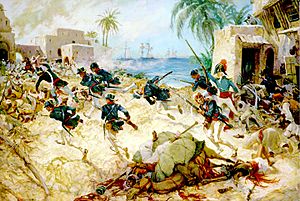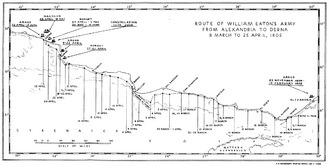Battle of Derna (1805) facts for kids
Quick facts for kids Battle of Derna |
|||||||
|---|---|---|---|---|---|---|---|
| Part of the First Barbary War | |||||||
 William Eaton leading the attack on Derna |
|||||||
|
|||||||
| Belligerents | |||||||
| Commanders and leaders | |||||||
| Strength | |||||||
| 8 U.S. Marines 400–500 Arab-Greek mercenaries 1 sloop 1 brig 1 schooner |
Unknown | ||||||
| Casualties and losses | |||||||
| 14+ killed and wounded | Unknown | ||||||
The Battle of Derna was an important fight during the First Barbary War (1801–1805). It took place in April and May 1805 in Derna, a city in North Africa. This battle was a big win for a special army led by United States Marines and U.S. Army Lieutenant William Eaton.
Eaton was a diplomat for the United States in Tripoli. He worked with U.S. Marine Corps First Lieutenant Presley Neville O'Bannon. Their army had to march a very long distance, about 521 miles (839 km), through the desert. They went from Alexandria, Egypt, to Derna, which was guarded by many more soldiers.
The Battle of Derna and the larger First Barbary War showed how the United States had to deal with piracy (sea robbers). It also showed how the young United States worked to protect its interests in the Mediterranean Sea.
Contents
Why the Battle Happened
In 1804, William Eaton returned to the Mediterranean Sea. He was now a special agent for the U.S. Navy. His job was to deal with the Barbary States, which were in North Africa.
Eaton had permission from the United States government and President Thomas Jefferson. He was allowed to support Hamet Karamanli. Hamet was the rightful ruler of Tripoli. However, his brother, Yusuf Karamanli, had taken his place. Yusuf had removed Hamet from power.
Hamet was not in the country when this happened. He decided to stay away for a while. When Eaton came back to the area, he found Hamet in Egypt. Hamet agreed to Eaton's plan to help him get his throne back.
Commodore Samuel Barron was the new U.S. Navy commander in the Mediterranean. He gave Eaton naval support. Several small warships from the United States Navy helped. These ships were the USS Nautilus, led by Oliver Hazard Perry. There was also the USS Hornet, under Samuel Evans. And the USS Argus, captained by Isaac Hull. These three ships would fire cannons from the sea to help the land attack.
Consul Eaton also got a small group of seven United States Marines. They were led by First Lieutenant Presley O'Bannon. Eaton and O'Bannon set up their base in Alexandria, Egypt. With Hamet Karamanli's help, they gathered about 400 Arab and Greek mercenaries. Mercenaries are soldiers who fight for money. Eaton made himself the general and leader of this group.
The Long March to Derna
On March 8, 1805, Lieutenant Eaton began a long journey. He led his forces about 500 miles (800 km) west. They marched across the Libyan desert from Egypt. Their goal was the port city of Derna. Derna was the main city of the Ottoman area called Cyrenaica. This area is now in eastern Libya.
The mercenary soldiers were promised supplies and money when they reached Derna. The march took 50 days. During this time, Eaton worried about problems between the Christian Greeks and the Muslim Arab and Turkish mercenaries. There were about 200 to 300 Muslim fighters.
The expedition's supplies started to run out. Eaton wrote in 1805 that their food was "a handful of rice and two biscuits a day." At one point, some Arab soldiers tried to steal from the supply wagon. The Marines and a few Greek artillerymen stopped them. They used the expedition's only cannon.
There were threats of mutiny (soldiers rebelling) several times. Between March 10 and March 18, some Arab camel drivers rebelled. This happened before they reached Massouah Castle. From March 22 to March 30, more Arab mercenaries rebelled. They were led by Sheik el Tahib. By April 8, Eaton had stopped these rebellions. He then crossed into Libya and Tripoli.
In late April, Eaton's force finally reached the port city of Bomba. This city is on the Gulf of Bomba, a few miles from Derna. The U.S. Navy warships Argus, Nautilus, and Hornet were waiting there. Commodore Barron and Captain Hull were with them. Eaton received fresh supplies and money to pay his mercenaries.
The Battle Begins
On the morning of April 26, Eaton sent a letter to Mustafa Bey. He was the governor of Derna. Eaton asked for safe passage through the city and more supplies. But Eaton knew the governor would likely say no. Mustafa reportedly wrote back, "My head or yours!"
On the morning of April 27, Eaton saw a fort in Derna with eight cannons. The brig USS Argus sent a cannon ashore to help with the attack. Captain Hull's ships then started firing. They bombed Derna's defenses for an hour.
Meanwhile, Eaton split his army into two groups. Hamet was to lead the Arab mercenaries southwest. Their job was to cut off the road to Tripoli. Then, they would attack the city's left side. They would also storm the governor's palace, which was not well defended.
Eaton, with the rest of the mercenaries and the Marines, would attack the harbor fort. Hull and the ships would keep firing on the strong port defenses.
Fighting for Derna
The attack started at 2:45 p.m. Lieutenant O'Bannon and his Marines led the way. O'Bannon led his Marines and 50 Greek gunners. They had the cannon from the Argus. But the cannon became less useful. The crew accidentally left the ramrod in the barrel and fired it away.
The harbor defenses were very strong. The attackers were stopped for a short time. However, this made other parts of the city weaker. This allowed the Arab mercenaries to ride into the western part of the city without much resistance.
Eaton's mercenary army was hesitant under the enemy's gun fire. He realized that charging forward was the only way to get control back. He led the charge himself. He was badly wounded in the wrist by a musket ball.
On the Argus, Captain Hull saw the Americans and mercenaries. He noted they were "gaining ground very fast." The ships stopped firing to let the charge continue. Eaton reported that O'Bannon, with his Marines and Greeks, "passed through a shower of Musketry from the Walls of houses." They then "took possession of the Battery."
The defenders quickly ran away. They left their cannons loaded and ready to fire. O'Bannon raised the American flag over the fort. It was the flag with 15 stars and 15 stripes, used from 1795 to 1818. Eaton then used the captured cannons to fire on the city.
Hamet's group had taken the governor's palace. They had secured the western part of the city. Many defenders of the harbor fort ran through the town. They ran right into Hamet's forces. By 4:00 p.m., the whole city had fallen. For the first time, an American flag flew over a fort across the Atlantic Ocean.
According to historical records, two Americans were killed and three were wounded. Nine Christian Greek mercenaries were killed or wounded. The number of casualties for the Muslim Turkish or Arab mercenaries and the defenders is unknown.
After the City Fell
Yusuf, who was in Tripoli to the west, knew about the attack on Derna. He sent more soldiers to the city. But by the time they arrived, Derna had already fallen. His men dug in and got ready to take the city back.
Eaton made his new position stronger. Hamet moved into the governor's palace. He assigned the Arab mercenary forces to patrol the outer areas of the city. Yusuf's men dug in south of the city and waited.
On May 13, they attacked Derna. They pushed Hamet's Arab forces back. They almost took back the governor's palace. But USS Argus and Eaton's captured cannons fired heavily on the attackers. The attackers finally ran away under the strong fire.
When night came, both sides were back in their original positions. There were small fights and other attempts to take the city in the next few weeks. But Derna stayed under American control.
From Derna, Eaton planned to march across the desert. He wanted to attack Tripoli from the land. During his march, he learned about a peace treaty. It was signed on June 10, 1805. The treaty was between American diplomat Tobias Lear and Yusuf Karamanli. In the middle of his journey, Eaton was told to go back to Egypt with Hamet.
What Happened Next
The Battle of Derna was the first land battle fought by the United States on foreign soil. This happened after the American Revolutionary War (1775–1783). It was the most important event of the First Barbary War (1801–1805). However, Eaton was very angry. He called the treaty a "sell-out" between the diplomat Tobias Lear and the ruler (bey).
Hamet returned to Egypt. The few Marines and Greek mercenaries left Derna without telling the Arab part of the force. The Arab mercenaries were left in Derna. They were never paid for what they had done.
William Eaton returned to the United States as a national hero. A story says that Hamet gave O'Bannon a special sword called a Mameluke sword. But there is no proof for this story. The first time someone mentioned Hamet giving O'Bannon a jeweled sword was in a newspaper article in 1917. One sword that was said to be this sword was later found to be a fake from a much later time. O'Bannon was later given a sword of honor by his home state of Virginia.
Another story says that O'Bannon's actions in North Africa inspired Marine Corps officers to use Mameluke swords. But this is also not supported by records from that time. Swords of this style were very popular in Europe. It is more likely that the Marines copied popular military leaders who wore them.
Lasting Impact
The attack on Derna inspired a line in the Marines' Hymn. The line is "to the shores of Tripoli."
In 1850, the American poet John Greenleaf Whittier wrote a poem called "Derne." It was written to remember this battle.
The USS O'Bannon (DD-450) was a Fletcher|destroyer|1. It was the U.S. Navy's most decorated destroyer during World War II. This ship was named in honor of First Lieutenant O'Bannon.
Images for kids




